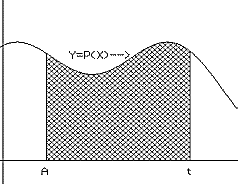
Theorem IV.4. [The Fundamental Theorem Of Calculus For Differential
Equations]
Suppose
that P is a positive continuous function on [A,B].
Then there is a function F so that F'(t) = P(t) for
all t where A < t < B.
In fact, F can be defined at x = t to be the area of
the region enclosed by the X-axis, the graph of the function P (i.e., Y
= P(X) ), the line X = A, and the line X = t. See Figure
IV.HA.i.
Figure IV.HA.i
Proof: For t > A let F(t) denote the
area of the region enclosed by the X- axis, X = A, X = t, and Y
= P(x).
Notice that F(A) = 0 because the "region" in this case is a line and
its area is 0.
We must show that F'(a) = P(a) for a > A,
so that F is a solution for the differential equation for the interval
[A,B]
We interpret the expression F(a+h) - F(a) when
h > 0
Consider the graph in Figure IV.HA.ii.
On this graph the region enclosed by the X-axis, X=a, X = a+h,
and the graph of Y = P(X) has area F(a + h) - F(a).
Examining this region more carefully in Figure
IV.HA.iii, we notice that since P is continuous on [a, a
+ h], P will have extreme values.
We let c* and c* denote the points
in [a, a + h] where P has its minimum and maximum
values.
Furthermore the region we are considering lies inside the rectangle
with base the segment of the X-axis between X = a and X = a +
h and height P(c* ).
The region also contains the rectangle with base the segment of the
X-axis between X = a and X = a + h and height P(c*).
This geometric situation means that
| Notes: 1. Another proof of this result in a slightly more general
setting is given in the next chapter.
2. Geometric Interpretation of F'(a) = P(a): This result has the same informational content as Barrow's Theorem discussed in Chapter 0. At this stage you might review the statement of Barrow's Theorem in terms of how to draw the tangent line at a point on the area curve determined by a given curve and the X-axis. Under an appropriate interpretation of the derivative as the slope of the tangent line, the proof of Barrow's Theorem given in the appendix to Chapter 0 gives a geometric argument that can be modified to justify Theorem IV.4 as well. 3. Velocity Interpretations of F'(a) = P(a): Consider P as a velocity function for some moving object, X, and F as a position function for another moving object,Y, with its position at time t being equal to the area of the region described in the theorem. Under this interpretation, the inequality Under the same interpretation, the inequality |